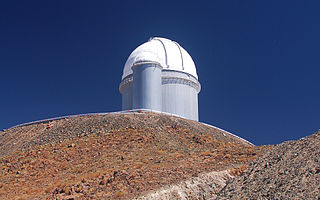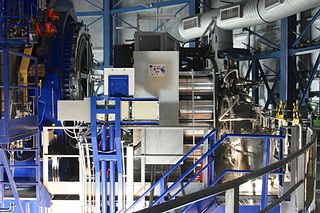
An optical spectrometer is an instrument used to measure properties of light over a specific portion of the electromagnetic spectrum, typically used in spectroscopic analysis to identify materials. The variable measured is most often the irradiance of the light but could also, for instance, be the polarization state. The independent variable is usually the wavelength of the light or a closely derived physical quantity, such as the corresponding wavenumber or the photon energy, in units of measurement such as centimeters, reciprocal centimeters, or electron volts, respectively.

The Very Large Telescope (VLT) is an astronomical facility operated since 1998 by the European Southern Observatory, located on Cerro Paranal in the Atacama Desert of northern Chile. It consists of four individual telescopes, each equipped with a primary mirror that measures 8.2 meters in diameter. These optical telescopes, named Antu, Kueyen, Melipal, and Yepun, are generally used separately but can be combined to achieve a very high angular resolution. The VLT array is also complemented by four movable Auxiliary Telescopes (ATs) with 1.8-meter apertures.

The Large Binocular Telescope (LBT) is an optical telescope for astronomy located on 10,700-foot (3,300 m) Mount Graham, in the Pinaleno Mountains of southeastern Arizona, United States. It is a part of the Mount Graham International Observatory.

The W. M. Keck Observatory is an astronomical observatory with two telescopes at an elevation of 4,145 meters (13,600 ft) near the summit of Mauna Kea in the U.S. state of Hawaii. Both telescopes have 10 m (33 ft) aperture primary mirrors, and, when completed in 1993 and 1996, they were the largest optical reflecting telescopes in the world. They are currently the third and fourth largest.

Observational astronomy is a division of astronomy that is concerned with recording data about the observable universe, in contrast with theoretical astronomy, which is mainly concerned with calculating the measurable implications of physical models. It is the practice and study of observing celestial objects with the use of telescopes and other astronomical instruments.

The Gemini Observatory comprises two 8.1-metre (26.6 ft) telescopes, Gemini North and Gemini South, situated in Hawaii and Chile, respectively. These twin telescopes offer extensive coverage of the northern and southern skies and rank among the most advanced optical/infrared telescopes available to astronomers. (See List of largest optical reflecting telescopes).

The Southern African Large Telescope (SALT) is a 9.2-metre optical telescope designed mainly for spectroscopy. It consists of 91 hexagonal mirror segments each with a 1-metre inscribed diameter, resulting in a total hexagonal mirror of 11.1 by 9.8 m. However, its effective aperture is only 9.2 m. It is located close to the town of Sutherland in the semi-desert region of the Karoo, South Africa. It is a facility of the South African Astronomical Observatory, the national optical observatory of South Africa.

The ESO 3.6 m Telescope is an optical reflecting telescope run by the European Southern Observatory at La Silla Observatory, Chile since 1977, with a clear aperture of about 3.6 metres (140 in) and 8.6 m2 (93 sq ft) area.

The Space Telescope Imaging Spectrograph (STIS) is a spectrograph, also with a camera mode, installed on the Hubble Space Telescope. Aerospace engineer Bruce Woodgate of the Goddard Space Flight Center was the principal investigator and creator of the STIS. It operated continuously from 1997 until a power supply failure in August 2004. After repairs, it began operating again in 2009. The spectrograph has made many important observations, including the first spectrum of the atmosphere of an extrasolar planet, HD 209458b.

The Wide Field and Planetary Camera 2 (WFPC2) is a camera formerly installed on the Hubble Space Telescope. The camera was built by the Jet Propulsion Laboratory and is roughly the size of a baby grand piano. It was installed by servicing mission 1 (STS-61) in 1993, replacing the telescope's original Wide Field and Planetary Camera (WF/PC). WFPC2 was used to image the Hubble Deep Field in 1995, the Engraved Hourglass Nebula and Egg Nebula in 1996, and the Hubble Deep Field South in 1998. During STS-125, WFPC2 was removed and replaced with the Wide Field Camera 3 as part of the mission's first spacewalk on May 14, 2009. After returning to Earth, the camera was displayed briefly at the National Air and Space Museum and the Jet Propulsion Laboratory before returning to its final home at the Smithsonian's National Air and Space Museum.

The High Accuracy Radial Velocity Planet Searcher (HARPS) is a high-precision echelle planet-finding spectrograph installed in 2002 on the ESO's 3.6m telescope at La Silla Observatory in Chile. The first light was achieved in February 2003. HARPS has discovered over 130 exoplanets to date, with the first one in 2004, making it the most successful planet finder behind the Kepler space observatory. It is a second-generation radial-velocity spectrograph, based on experience with the ELODIE and CORALIE instruments.

The Multi-Unit Spectroscopic Explorer (MUSE) is an integral field spectrograph installed at the Very Large Telescope (VLT) of the European Southern Observatory (ESO). It operates in the visible wavelength range, and combines a wide field of view with a high spatial resolution and a large simultaneous spectral range. It is specifically designed to take advantage of the improved spatial resolution provided by adaptive optics, offering diffraction-limited performance in specific configurations. MUSE had first light on the VLT’s Unit Telescope 4 (UT4) on 31 January 2014.
The UK Schmidt Telescope (UKST) is a 1.24 metre Schmidt telescope operated by the Australian Astronomical Observatory ; it is located adjacent to the 3.9 metre Anglo-Australian Telescope at Siding Spring Observatory, Australia. It is very similar to the Samuel Oschin telescope in California. The telescope can detect objects down to magnitude 21 after an hour of exposure on photographic plates.

International Ultraviolet Explorer, was the first space observatory primarily designed to take ultraviolet (UV) electromagnetic spectrum. The satellite was a collaborative project between NASA, the United Kingdom's Science and Engineering Research Council and the European Space Agency (ESA), formerly European Space Research Organisation (ESRO). The mission was first proposed in early 1964, by a group of scientists in the United Kingdom, and was launched on 26 January 1978 aboard a NASA Thor-Delta 2914 launch vehicle. The mission lifetime was initially set for 3 years, but in the end it lasted 18 years, with the satellite being shut down in 1996. The switch-off occurred for financial reasons, while the telescope was still functioning at near original efficiency.

The Cosmic Origins Spectrograph (COS) is a science instrument that was installed on the Hubble Space Telescope during Servicing Mission 4 (STS-125) in May 2009. It is designed for ultraviolet (90–320 nm) spectroscopy of faint point sources with a resolving power of ≈1,550–24,000. Science goals include the study of the origins of large scale structure in the universe, the formation and evolution of galaxies, and the origin of stellar and planetary systems and the cold interstellar medium. COS was developed and built by the Center for Astrophysics and Space Astronomy (CASA-ARL) at the University of Colorado at Boulder and the Ball Aerospace and Technologies Corporation in Boulder, Colorado.

The Wide Field Camera 3 (WFC3) is the Hubble Space Telescope's last and most technologically advanced instrument to take images in the visible spectrum. It was installed as a replacement for the Wide Field and Planetary Camera 2 during the first spacewalk of Space Shuttle mission STS-125 on May 14, 2009.

The Large Sky Area Multi-Object Fibre Spectroscopic Telescope (LAMOST), also known as the Guo Shoujing Telescope after the 13th-century Chinese astronomer, is a meridian reflecting Schmidt telescope, located in Xinglong Station, Hebei Province, China. Undertaken by the Chinese Academy of Sciences, the telescope is planned to conduct a 5-year spectroscopic survey of 10 million Milky Way stars, as well as millions of galaxies. The project's budget is RMB 235 million yuan.

Integral field spectrographs (IFS) combine spectrographic and imaging capabilities in the optical or infrared wavelength domains (0.32 μm – 24 μm) to get from a single exposure spatially resolved spectra in a bi-dimensional region. The name originates from the fact that the measurements result from integrating the light on multiple sub-regions of the field. Developed at first for the study of astronomical objects, this technique is now also used in many other fields, such bio-medical science and Earth remote sensing. Integral field spectrography is part of the broader category of snapshot hyperspectral imaging techniques, itself a part of hyperspectral imaging.

The NIRSpec is one of the four scientific instruments flown on the James Webb Space Telescope (JWST). The JWST is the follow-on mission to the Hubble Space Telescope (HST) and is developed to receive more information about the origins of the universe by observing infrared light from the first stars and galaxies. In comparison to HST, its instruments will allow looking further back in time and will study the so-called Dark Ages during which the universe was opaque, about 150 to 800 million years after the Big Bang.

The Visible Multi-Object Spectrograph (VIMOS) is a wide field imager and a multi-object spectrograph installed at the European Southern Observatory's Very Large Telescope (VLT), in Chile. The instrument used for deep astronomical surveys delivers visible images and spectra of up to 1,000 galaxies at a time. VIMOS images four rectangular areas of the sky, 7 by 8 arcminutes each, with gaps of 2 arcminutes between them. Its principal investigator was Olivier Le Fèvre.



















